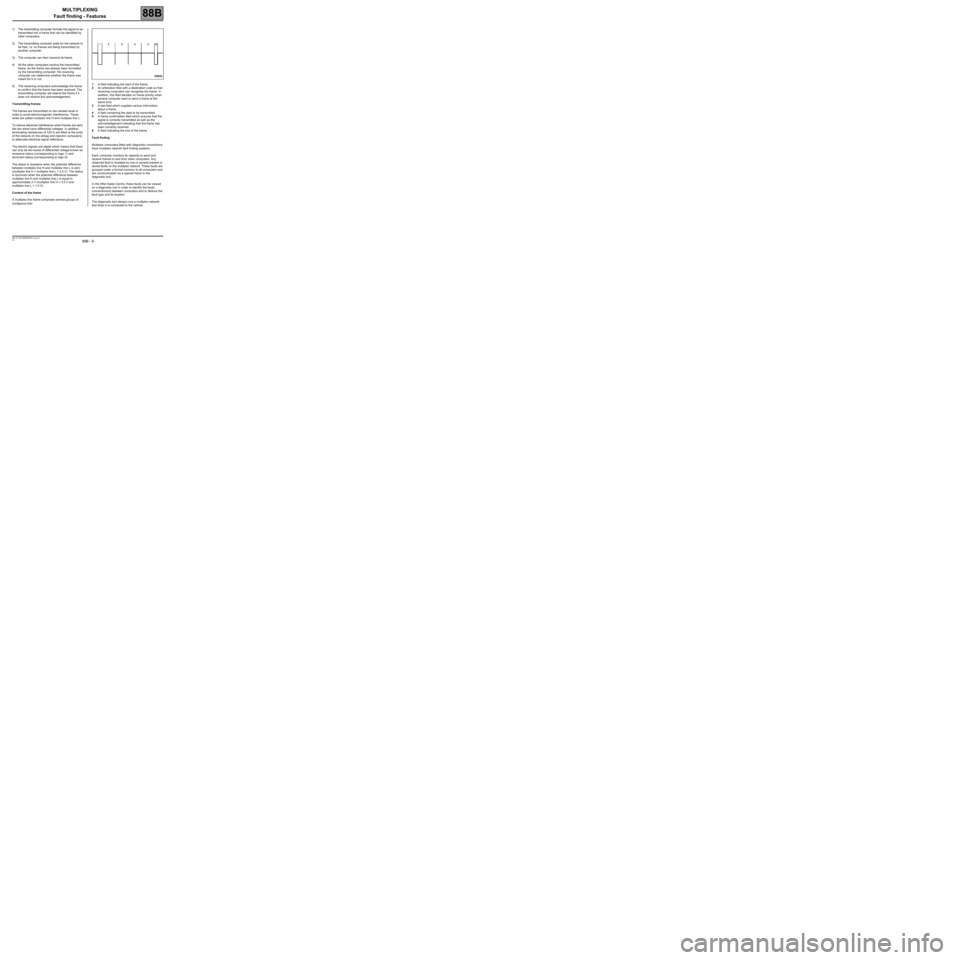differential RENAULT SCENIC 2008 J84 / 2.G Electrical Equipment - Multiplexing Workshop Manual
[x] Cancel search | Manufacturer: RENAULT, Model Year: 2008, Model line: SCENIC, Model: RENAULT SCENIC 2008 J84 / 2.GPages: 25, PDF Size: 0.09 MB
Page 9 of 25

MULTIPLEXING
Fault finding - Features
88B - 9
88B
V4 MR-372-J84-88B050$400_eng.mif
1) The transmitting computer formats the signal to be
transmitted into a frame that can be identified by
other computers.
2) The transmitting computer waits for the network to
be free, i.e. no frames are being transmitted by
another computer.
3) The computer can then transmit its frame.
4) All the other computers receive the transmitted
frame. As the frame has already been formatted
by the transmitting computer, the receiving
computer can determine whether the frame was
meant for it or not.
5) The receiving computers acknowledge the frame
to confirm that the frame has been received. The
transmitting computer will resend the frame if it
does not receive this acknowledgement.
Transmitting frames
The frames are transmitted on two twisted wires in
order to avoid electromagnetic interference. These
wires are called multiplex line H and multiplex line L.
To reduce electrical interference when frames are sent,
the two wires have differential voltages. In addition,
terminating resistances of 120 Ω are fitted at the ends
of the network (in the airbag and injection computers)
to attenuate electrical signal reflections.
The electric signals are digital which means that there
can only be two levels of differential voltage known as
recessive status (corresponding to logic 1) and
dominant status (corresponding to logic 0).
The status is recessive when the potential difference
between multiplex line H and multiplex line L is zero
(multiplex line H = multiplex line L = 2.5 V). The status
is dominant when the potential difference between
multiplex line H and multiplex line L is equal to
approximately 2 V (multiplex line H = 3.5 V and
multiplex line L = 1.5 V).
Content of the frame
A multiplex line frame comprises several groups of
contiguous bits:1A field indicating the start of the frame.
2An arbitration field with a destination code so that
receiving computers can recognise the frame. In
addition, this field decides on frame priority when
several computer want to send a frame at the
same time.
3A test field which supplies various information
about a frame.
4A field containing the data to be transmitted.
5A frame confirmation field which ensures that the
signal is correctly transmitted as well as the
acknowledgement indicating that the frame has
been correctly received.
6A field indicating the end of the frame.
Fault finding
Multiplex computers fitted with diagnostic connections
have multiplex network fault finding systems.
Each computer monitors its capacity to send and
receive frames to and from other computers. Any
observed fault is revealed by one or several present or
stored faults on the multiplex network. These faults are
grouped under a format common to all computers and
are communicated via a special frame to the
diagnostic tool.
In the After-Sales Centre, these faults can be viewed
on a diagnostic tool in order to identify the faulty
connections(s) between computers and to deduce the
fault type and its location.
The diagnostic tool always runs a multiplex network
test when it is connected to the vehicle.
Page 10 of 25

MULTIPLEXING
Fault finding - Defect and safe modes
88B - 10
88B
V4 MR-372-J84-88B050$500_eng.mif
MULTIPLEXING
Fault finding - Defect and safe modes
The multiplexing function does not have a safe mode
program.
However, the multiplexing function may have special
operation features.
The multiplex network still functions when multiplex
line L is in short circuit to earth. The voltage on
multiplex line H is no longer differential; it corresponds
to earth.
MR-372-J84-88B050$500_eng.mif